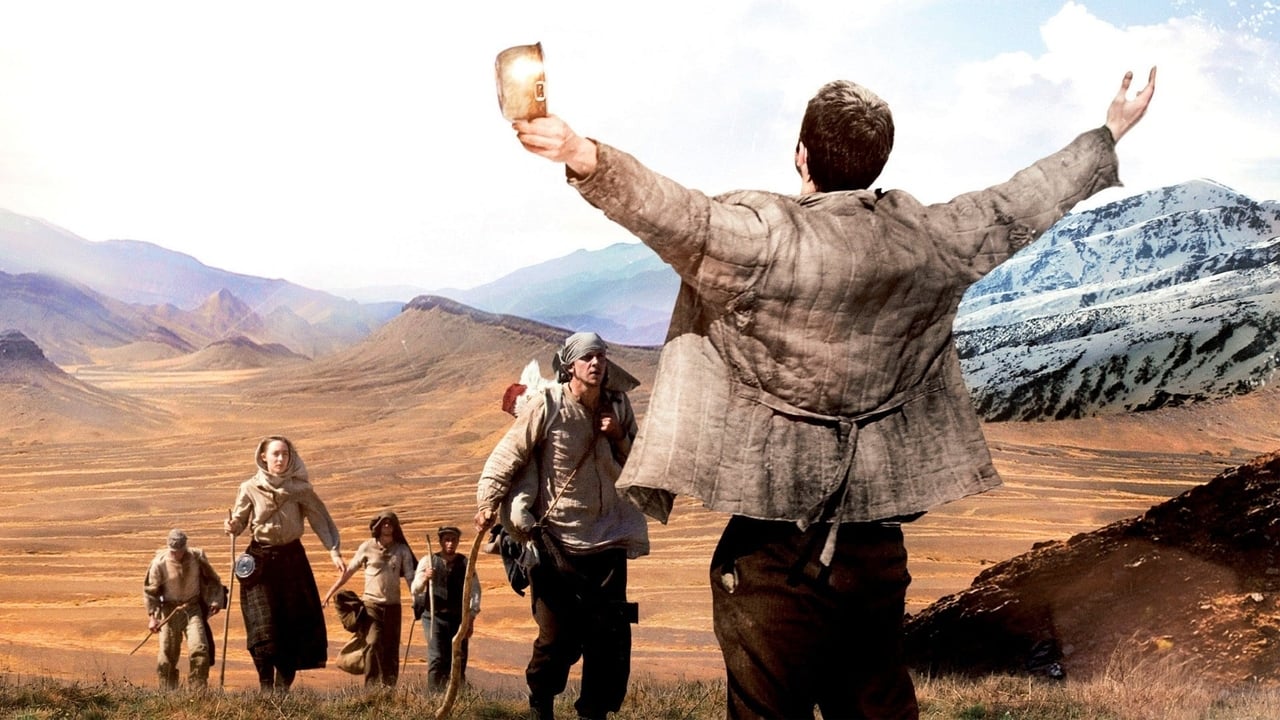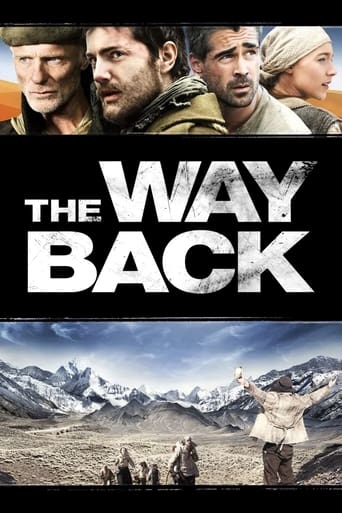

Great movie i have ever seen .head off to real hero
... View MoreThe film The Way Back is a thrilling story which details the escape of prisoners from a Soviet Gulag and the journey they must embark on in order reach a nation without communist sympathies. The opening of the movie was the strongest and most poignant part of the film as the first thirty minutes details the prisoners' experiences within the Gulag. The sequences in the Gulag make the viewer feel extremely claustrophobic, particularly during the scenes which take place in the mines, and creates an overall feeling of dread which causes the experience of viewing the film to feel more real. Moreover, the depictions of the day to day occurrences in Gulag are fairly accurate as the bartering systems displayed in the film and the prison social hierarchies were prominent features of life within a Soviet Gulag. The film was also able to explain how small infractions such as performing in a film could result in one's imprisonment within the Gulag. To improve the depiction of the Gulag from both a historic and emotional lens, the director, Peter Weir, could have taken more steps to make the death displayed within the Gulag more impactful for the viewer. Gulags were incredibly dangerous as about one in four prisoners in the Gulags died each year (Alexopoulos, "Illness and Inhumanity in Stalin's Gulag"). While the film shows that some prisoners died from exposure, all the prisoners who die within the camp are nameless Gulag prisoners. It would have been more impactful if one of the detainees who was planning on escaping the Gulag died before they were able to leave. Following the escape from the Gulag, the six prisoners embark on a journey with the goal of reaching Mongolia. The actual journey depicted within the film suffers from poor directing and screenwriting choices. Some parts of the journey depicted in the film such as when the escapees are traveling through China felt rushed whereas other aspects of the journey such as the initial trek through Russia could have been edited down. The strange depiction of time within the film prevented the viewer from having an accurate sense how long the journey took. Moreover, the survival aspects of the film such as the encounter with the sandstorm or the intense heat were not as interesting as the narratives the characters told about their experiences in the Soviet Union. The most disappointing part of the entire film was the ending which involved the leader of the prisoners, Janusz Wieszczek, reuniting with his after fifty years of separation. The ending seemed impossible even when compared to the almost impossible feat of traveling from Siberia to India. I would have preferred the film to end with the completion of the journey instead of the strange husband and wife reunion as it appeared to cheapen the quality of the film.
... View MoreI saw this movie some years ago, or more accurately I saw half this movie some years ago. Maybe I was having a bad day but at the time I just couldn't summon the enthusiasm to see it through. So when I saw it advertised recently to appear on television I thought I would give it another shot. This time round I made it as far as Mongolia, which I suppose is progress. That I got this far is probably because this time around I noticed that it was directed by Peter Weir and because I am a big fan of Gallipoli I gave it more leeway and time for development. Alas my patience and respect for Peter Weir were not rewarded on this occasion. There is something very fundamentally wrong with this movie, or perhaps the story itself does not lend itself to audience engagement, at least on the big screen. Peter Weir's genius in Gallipoli was to make a "war" film (or actually an "anti-war" film) by showing practically nothing of war. 80% of that movie was about building up the characters and the relationship between them, and because we know them so well we actually care about what happens at the end. In "The Way Back" Peter Weir seems to have forgotten about the need for audience identification with characters. Perhaps I missed a few things with the bas russian accents and names that do not register after hearing them once but quite frankly I had no idea who those people traipsing around Siberia were and even less idea why I should care. I think (but I am not sure) that there is one key protagonist (the one we see being interrogated at the beginning) and a bunch of other guys, but that is hard to tell because they all look and sound the same. If that were not bad enough these strangers do stuff that anyone would do in that situation and they do it for a long time against a backdrop that looks basically the same. I had no idea where they were going and no idea of the distances involved or the absolute immensity of the landscape, be it Siberia or Mongolia. A map and some aerial shots would have helped enormously for as it is it looks like they are off for a weekend tramp. We have absolutely no concept of the magnitude of their feat, which I would have thought is the whole point of the film.Our heroes, whoever they are, are so clueless that they have to batter a watch with some genius who tells them they must turn off the generator and cut the wires to escape. Bravo, that is certainly a plan and a half. How they disabled the generator, or cut the wires, we are not shown, nor are we shown how they escape dozens of guards and dogs in hot pursuit. And yes, we have a BLIND man thrown in for good measure, that's right, not just a BLIND man but one who indulges in syrupy flashbacks. And then, blow me down, if our intrepid team don't meet a pretty young girl partway along and for reasons best known to themselves they skip across some ice together. It is all very lazy, uninspired and unbelievable stuff.Eventually our band of heroes gets to the Mongolian border and comes across a huge archway in the middle of nowhere...ah...what? They are surprised to learn that China is also a communist country, which in 1941 was not actually true.Annoyingly, despite starting the movie with people speaking their actual languages and having English subtitles, as soon as we get to the Gulag everyone amazingly speaks heavily accented English. Perhaps this approach would have cut the mustard 30 years ago when all Hollywood Germans spoke like Colonel Klink, but in this day and age portraying foreign language by using badly accented English is just plain embarrassing to all involved. Quite apart from the embarrassment these rotten accents made it difficult to understand what anyone was saying, and because one actor's poor impression of a Russian speaking English sounds much like another's poor impression of a Russian speaking English, it only made trying to figure out who was who even worse.OK, this is not the worst movie in the World and indeed I see that many people think this movie is the best thing since sliced bread. I'm glad others enjoyed it, but for me it was an emotionless and heartless experience, which ultimately I had to terminate because I found the boredom of real life more interesting.
... View MoreThis great Movie sometimes feels like a National Geographic book that you enjoy from your seat Yes, the Characters do get some malnourishment , and some do die from the trek, but the lighting is made well the clothing the actors ware draws you in as a viewer to believe the place and time is relevant ,to say the least, and the escapees do bond enough to make it as a team, but there is, unrealistically, not enough conflict and Drama. It is all handled in such a delicate way, that it is too delicate for its own good. It is without much tension and it all plays out so gentile that the Movie is OK to watch but there is way too little to feel, what would make the movie better, is more conflict and more drama, they don't explain the other stories of the other escapees, like what happened to valka, and the other guys , its okay just wish it was more engaging
... View More